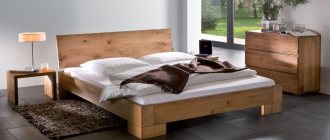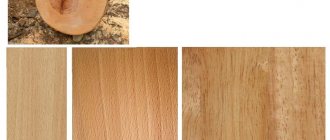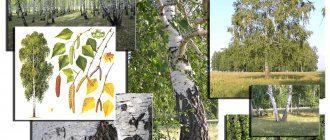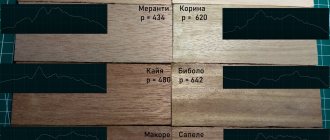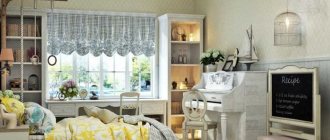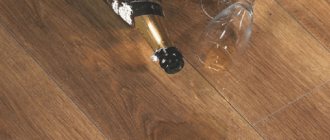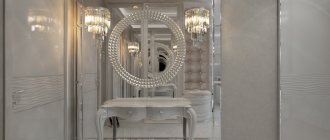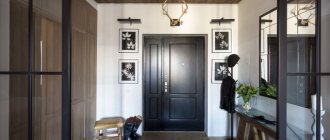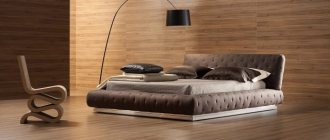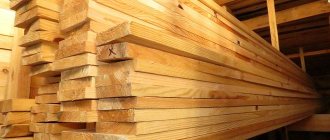Modern furniture manufacturers offer a variety of options for making custom-made furniture. And one of the issues that you need to decide is the choice of material. Today we will compare the advantages and disadvantages of the most popular furniture materials - chipboard, MDF and solid wood .
Furniture made from chipboard and MDF, in comparison with furniture made from solid wood, has a seemingly undeniable advantage - a more affordable price. But what exactly will this mean once you start using this furniture?
Chipboard: advantages and disadvantages
So, chipboard is a material that is obtained by mixing and pressing dried industrial chips and resins.
- Chipboard has two significant disadvantages:
- does not hold screws and nails well;
- environmental unsafety.
As a result, it turns out that furniture made of chipboard, if necessary, will be quite difficult for you to repair: once a screw has fallen out, you will have to screw it in again and again. And by definition, there is a chance that it will fall out - chipboard, in principle, does not “accept” foreign bodies well.
The bigger issue is your family's health. The resins that are used in the production of chipboards tend to emit formaldehyde, which is harmful to your health. For this reason, a very important parameter when choosing a material is the permissible concentration of harmful substances per specific volume.
Unfortunately, cheap, low-grade slabs that do not meet established standards are not so rare these days. This means that there is a possibility that, having saved on buying furniture for the living room or bedroom, you will have to spend a significantly larger amount on restoring your health. Even the concentration of formaldehyde that may be present in a room with low-quality furniture can cause headaches and loss of strength. It is not in vain that slabs of the E1 class (quite popular in Russia) are no longer produced abroad, but only slabs of the “Super E” class are produced. By the way, another important point: in the Russian Federation, E2 class slabs are prohibited from being used for the production of children's furniture, which, alas, does not at all mean that such furniture is not available for sale.
Conclusion:
Chipboard is unreliable and dangerous.
Advantages of solid wood furniture
The advantage of buying models made from natural wood is their durability. The material has a high density, is dried using a special technology, and treated with impregnations for strength. Therefore, it does not deform, does not crack, and can withstand heavy loads well. Other benefits include:
- Beauty. The original texture of the material is preserved, and impregnations help highlight it and give it the desired shade. You can make carved facades and massive figured legs from wood.
- Quality. Items are not afraid of moisture and are not susceptible to insects or mold.
- Durability. As we already mentioned, the item will serve you for decades. It can always be updated and restored if the fittings break or the varnish wears off.
- Safety. Unlike particle board materials, there is no risk that harmful substances and dubious additives were used in production.
Like everything natural, the products are quite expensive. The material itself is not cheap, but thanks to its beauty and reliability, the purchase is worth it in the long run.
Pros and cons of MDF
MDF, or medium density fiberboard, is a material that is made by dry pressing wood chips with carbide resins modified with melamine. The cost of MDF is higher than the cost of chipboard. But the material is worth it: first of all, MDF does not emit substances hazardous to health . And the strength of MDF is on average two times higher than the strength of chipboard. This material has another important advantage - it makes possible a wide variety of furniture designs, since it can imitate natural wood, metal, and glass.
Does MDF have any disadvantages?
Yes. This is a highly flammable material, for which the potential risk of ignition is not only contact with an open flame, but also contact with quickly heated surfaces, and even faulty wiring laid next to MDF furniture. MDF boards are often characterized by low resistance to moisture. However, these shortcomings can be eliminated through special production technologies that make the material waterproof, fireproof and bioresistant. But you understand that “special production technology” are words that also mean a higher price. And therefore, the comparison of prices for furniture made of MDF and solid wood becomes not so bright.
Another disadvantage of MDF is its vulnerability to mechanical stress. Of course, you won't break MDF furniture with your finger, but is it possible to rule out stronger impacts with absolute certainty?
Conclusion:
not always reliable, but safe.
MDF furniture - a convenient alternative to solid wood?
MDF is not inferior to natural materials in terms of prevalence on the market. MDF boards are made from natural chips, which are mixed with a binder and pressed. The result is a sheet of the required thickness that can be cut and used.
MDF has several advantages:
- Affordable price. The cost is much lower than that of natural analogues. This allows you to make the purchase of both individual items and headsets much more affordable.
- Beauty. Lamination and veneering are used. Technologies make it possible to convey the natural texture and color of wood of different types.
- Versatility. This option is suitable for the production of most items in the house.
You should always remember that the quality and safety of the material largely depend on the manufacturer and the honesty of the seller. If the supplier is trusted, you don’t have to worry about harmful fumes or unpleasant odors. But if you try to save money and place an order in an unverified place, you may encounter a full range of problems - from swelling and peeling of the decorative coating to the release of harmful fumes.
Solid wood: pros and cons
Finally, a tree. Of course, you have thought more than once that this is probably the most capricious material for furniture precisely because of its nature. Yes, in some ways this is true. For example, oak, even after it has been transformed from wood into furniture, remains an aristocrat. Oak furniture requires special treatment: for example, you cannot place a hot mug on it. And if it is also waxed furniture, and you have a habit of smoking, then you will see on the surface of your furniture what is happening inside your body. The tree will continue to breathe, which means it will absorb smoke and odors. Yes, solid wood furniture will require your attention and respect. But what will she give you in return?
- Eat four advantages of natural furniture
- environmental friendliness . Cabinet furniture made from solid wood will in no way harm your health: it simply does not contain toxic impurities.
- practicality _ Yes, we started our conversation about wood as a capricious material. But the fact is that precisely because of its natural properties, solid wood is more resistant to both moisture and rot than chipboard and MDF. In addition, the modern market offers different coatings for furniture made from natural solid wood, which means that the degree of protection of the solid wood can be very high. Just choose furniture made of natural wood, coated with polyurethane varnish - and you can forget about the problem of a hot mug!
- aesthetics . Remember when we said that the surface of MDF can imitate wood? But this is still nothing more than an imitation. And the only thing more beautiful than just furniture made of natural wood is very good furniture made of natural wood.
- energy of wood . We all know that trees are able to share the pure energy of nature with us. That oak is a tree that helps you gain clarity of thought and strength, and beech charges you with invigorating energy. But have you heard this about chipboard? Hardly. But the fact that formaldehyde, which is emitted by chipboards, can cause depression is a scientifically proven fact.
, in which neither chipboard furniture nor MDF furniture can yet compare with it:
So it turns out that investing in furniture made from natural wood is not just a practical and environmentally friendly choice for a person who appreciates the graceful simplicity of nature. It is also an investment in the health and harmony of your family.
Conclusion:
reliable and useful.
Chipboard, MDF, solid wood: which furniture is better?
We'll tell you whether solid wood furniture is always made from a single piece of wood, why chips are dangerous on countertops and laminated chipboard facades, and what furniture is ideal for the kitchen and bathroom.
The content of the article:
- What are chipboard and chipboard?
- Myths and truth about formaldehyde in furniture
- What is MDF?
- Furniture made from solid natural wood
What are chipboard and chipboard?
Chipboard - chipboard. It is made from wood chips using a molding method with thermosetting synthetic resin. Simply put, sawdust is pressed and glued with a special compound, and the resulting canvas is cut to the desired format and sanded. Chipboard consists of shavings, sawdust from low-value wood species and shredded reclaimed wood. The surface of chipboard furniture is matte and porous, rough to the touch.
Chipboard can be low-, medium- and high-density. Low density - less than 550 kg/m³, medium - 550-750 kg/m³, high - more than 750 kg/m³. Theoretically, high density is preferable, since such a slab is stronger and more resistant to damage and deformation. However, since Soviet times, the density of the slab has often been increased by increasing the volume of glue, rather than by increasing the volume of chips. This is a bad option, because the toxicity of chipboard is directly proportional to the amount of glue in the composition.
There are two grades of chipboard: P-A and P-B. The first is superior to the second in strength and water resistance. Therefore, furniture is made from P-A grade chipboard. There is also a type of chipboard with increased water resistance. Instead of formaldehyde resins, it contains urea-melamine resins.
Advantages of chipboard furniture:
- Affordable price.
- Quite a large selection of color options.
- Easy care.
Disadvantages of chipboard furniture:
- It becomes deformed with prolonged and/or constant contact with moisture or in conditions of high humidity, mold and mildew appear.
- Scratch resistant.
- It is impossible to produce complex decorative elements; carving/embossing on the surface is impossible.
- Potential Health Hazard: Contains toxic urea-formaldehyde or phenol-formaldehyde resins.
LDSP - laminated chipboard. It differs from chipboard in that the finished particle board is laminated with a decorative facing film, for example, melamine or polyvinyl chloride. The film is paper impregnated with synthetic resins. Lamination occurs under high pressure and at a temperature of about 200 degrees. A durable glossy film is fixed to the surface of the chipboard. Its properties are similar to plastic. The glossy surface of laminated chipboard furniture is smooth to the touch.
Advantages of furniture made from chipboard:
- The material is more resistant to moisture and dirt than chipboard: the film on the surface prevents the absorption of water and stains, as well as the formation of mold.
- The strength of laminated chipboard is higher than chipboard.
- Larger selection of colors compared to chipboard.
- Easy care.
Disadvantages of furniture made from chipboard:
- A little more expensive than chipboard furniture.
- After prolonged contact with moisture, it may become deformed.
- Instability to chipping.
- It is impossible to produce complex decorative elements; carving/embossing on the surface is impossible.
- Toxic fumes (there is an opinion that there are fewer of them than with chipboard, since the synthetic film reduces the volume of fumes).
Most often, furniture is made from a combination of chipboard and laminated chipboard. Frame elements, shelves and drawers are usually made from chipboard, while the façade part is made from chipboard.
Myths and truth about formaldehyde in furniture
Is (L)chipboard as dangerous as it is portrayed in the media and marketing publications? Let's figure it out. Formaldehyde and phenol evaporate from furniture, and a person inhales these fumes all the time while he is at home. Formaldehyde is a carcinogen, which means it can cause cancer. In addition, it can cause chronic pneumonia and allergic reactions.
However, formaldehyde is constantly found in human blood and is necessary for the proper functioning of organs. Even solid wood emits formaldehyde, but natural wood is considered the most environmentally friendly and safe material for making furniture. Concentrations of toxic substances seem to matter. Scientists conducted studies and stated: health risks can be assessed by knowing the emission class of formaldehyde, i.e. free formaldehyde content in 100 g of dry board. European standards, by the way, are slightly different from Russian ones.
| European standards | Russian GOSTs | ||
| Emission class | Limit volume of formaldehyde evaporation | Emission class | Limit volume of formaldehyde evaporation |
| E0.5 | up to 4 mg/100 g | — | — |
| E1 | up to 8 mg/100 g | E1 | up to 10 mg/100 g |
| E2 | 8—30 mg/100 g | E2 | 8—30 mg/100 g |
Experts recommend using furniture made of (L)chipboard with a minimum emission class. An emission class higher than E1 is a red flag when choosing: avoid it to avoid harm to health. Do not buy furniture if the seller cannot provide any information (supported by certificates) about the emission class. Remember that formaldehyde evaporation increases when heated above 30 degrees. Therefore, you should not place furniture near heating appliances. When purchasing, pay attention to whether all ends of the furniture are covered with edge tape. From open areas (as well as from places where there are chips and scratches), formaldehyde evaporates as actively as possible.
Research has shown that so far there is no alternative to synthetic resins containing formaldehyde in the production of particle boards. All substitutes tested were even more toxic. The volume of harmful fumes is reduced by natural veneer (a layer of wood 0.1 to 10 mm thick) and decorative cladding film, which is used in the manufacture of laminated chipboard (this film itself has a synthetic composition, and is therefore inferior to veneer).
What is MDF?
MDF is a translation of the English abbreviation MDF, which stands for Medium Density Fideboard. MDF is made from tiny wood fibers by dry pressing at high pressure and temperature. First, the logs are crushed, then the resulting substance is treated with steam. Natural adhesives such as paraffin or lignin (both substances of natural origin) are added to this mass. Then the mass is dried, pressed and cut.
MDF cannot be called a 100% natural material, because... Along with paraffin and lingin, synthetic urea resins are still added to it. And they contain formaldehyde. However, formaldehyde evaporates from urea resins in significantly smaller volumes than from glue in chipboard and laminated chipboard. Therefore, MDF is considered a much more environmentally friendly and safe material, which can even be used to make children's furniture.
Advantages of MDF furniture:
- Phenomenal strength. MDF is superior not only to chipboard, but sometimes even to natural wood in terms of hardness. Wood can be heterogeneous in structure, cracks and knots reduce strength, while MDF is monolithic and therefore consistently strong.
- The environmental friendliness of MDF is higher than chipboard and laminated chipboard, and is close to the performance of solid natural wood.
- Various design options. MDF allows you to design more complex shapes and create a variety of decorative elements (for example, pilasters). Unlike chipboard, it is suitable for milling, making bent surfaces, carving and embossing.
- An ideal choice for the bathroom and kitchen. The material is resistant to the formation of mold and fungi, high humidity and air temperature, as well as sudden temperature changes. Therefore, MDF furniture does not swell or deform under the influence of kitchen steam or fumes in the bathroom. But there is a nuance: only MDF, painted on both sides, is most resistant to constant high humidity. Manufacturers can save money and leave the back side of the facades white.
- Durable MDF holds furniture fittings better than (L)chipboard.
- MDF is cheaper than solid wood, but has almost all its advantages.
Disadvantages of MDF:
- Much more expensive than (L)chipboard.
- Heavier than (L)chipboard, which is inconvenient when assembling, rearranging and moving.
- Not 100% natural composition.
Corner house “Willie Rabbit”
Cabinet Adagio
- Corner house “Willie Rabbit”
- Cabinet Adagio
Furniture made from solid natural wood
The key difference between solid wood and MDF and (L)chipboard is that it is made from whole pieces of wood, and not from sawdust and shavings.
The massif is made from solid or glued solid wood. The first option is very expensive. It is difficult to find solid pieces of wood that are suitable in size without knots, cracks and other defects. Glued laminated wood is created from small pieces of wood. Several layers of wood are fastened into a furniture panel, using a small amount of glue (you don’t have to worry about toxic fumes). Solid wood is more expensive than glued wood, but glued wood is less finicky: it cracks and shrinks less often.
The cost of solid wood furniture also depends on the type of wood. Hard woods, such as beech, oak, and walnut, are more expensive than soft woods, such as pine or birch. The value of a rock is determined not only by its hardness, but also by the beauty of its design and moisture resistance. It should be understood that furniture is rarely made entirely of solid wood. Usually solid wood is combined with MDF; even furniture facades often combine solid wood, MDF and veneer.
Advantages of solid wood furniture:
- Status. Solid wood furniture is a classic addition to expensive interiors.
- Varied design. You can create complex structures from solid wood; it can be carved and milled.
- Uniqueness. Each tree has its own unique pattern, so it is impossible to find two identical solid wood products.
- Strength. Hard wood is used to create reliable, wear-resistant furniture that is difficult to accidentally scratch, not to mention dents.
- 100% environmentally friendly. Even glued solids emit a negligible amount of toxic fumes, which can be neglected when assessing the safety of the material for health.
Disadvantages of solid wood furniture:
- Moodiness. Furniture is demanding on the indoor microclimate, and also requires more complex care than MDF, chipboard and laminated chipboard. The massif is deformed under the influence of high humidity, shrinks from the heat, and is afraid of sudden changes in humidity and temperature.
- Heavy weight. The furniture is very heavy, which is inconvenient when moving and rearranging.
- Softwood furniture is not resistant to dents and scratches (but hardwoods do not have this problem!).
- Smaller choice of colors compared to laminated chipboard and MDF.
- High price.
Solid teak wardrobe KDS
Rack with workplace
Coffee table LINK
- Solid teak wardrobe KDS
- Rack with workplace
- Coffee table LINK
Furniture in the interior Interior design styles
Come to us for original ideas! We are located at: 1st Shchipkovsky lane, 4 Daily from 10.00 to 21.00
About saving raw materials and cost of doors
Just 70 years ago, natural solid wood was the only material for making interior doors. But the lack of natural resources forced us to look for other solutions. The reason is simple: from 1 m3 of high-quality solid wood, about 2.5-3 units of doors are produced, and from the same amount of industrially suitable wood - no more than 2.
Due to the shortage of raw materials, the price of solid wood doors has gradually turned them into premium products. In the middle price category, veneer and fine line reigned. Therefore, today the most optimal combination of “environmental friendliness - quality - price” is considered to be solid coniferous wood, lined with natural veneer.
From 1 m3 of wood you can get about 400 m2 of veneer, which is enough to make 10-15 doors. And if the tree is grown and processed using fine-line technology, 1m3 will be enough to produce 20-25 doors (less waste).
The use of cellular technology in the production of interior doors made of MDF (chipboard) has made it possible to fill the low price segment with a wide product range.
Of course, the quality of such products corresponds to the cost, but from 1 m3 of wood it is possible to obtain 50-65 doors of the following design:
- frame - MDF/chipboard, 5 cm thick (sometimes replaced with inexpensive wood);
- internal voids - “honeycombs” made of chipboard/MDF (wood boards with special internal round channels);
- external cladding – MDF sheets, which are additionally decorated (painting, laminate, veneer).
Natural solid wood in the production of interior doors
A door made entirely of furniture board is a beautiful and wear-resistant thing. Its cost depends, first of all, on the type of wood. Expensive wood used in mass production - beech, oak, maple, mahogany. The price for such doors “starts” at $500. Therefore, higher demand is noted for products made from “soft” wood (for example, pine, spruce), their cost is quite budgetary - from $200.
Solid wood is a material that is easy to store and process. Only thoroughly dried boards and panels can be used in production to avoid deformation and warping of the wood. At the same time, an array of low quality (for example, with knots or curved beams) is guaranteed to lead to defects. Therefore, when harvesting yourself, you sometimes have to reject up to 60% of lumber.
Advantages of the array:
- structural strength of the doors, reliable fastenings, good adhesion of the canvas to the finishing materials;
- the ability to launch a full production cycle workshop, which will allow you to independently produce raw materials for doors;
- a material that “speaks for itself” - massive doors do not need special advertising, they are known as a product of high quality and an appropriate price.
Flaws:
- unique individuality of the structure of each door;
- poor tolerance to humidity and temperature changes;
- a door made of solid wood has significant weight, so the fittings (especially door hinges and locks) must be of high quality, designed for high loads;
- there is a high probability of cracks forming in places where the lamellas are glued together when using low-quality glue or insufficient drying of the source material.
Therefore, during serial and mass production, solid interior doors are covered with a decorative and protective layer of natural veneer.
MDF as the basis of kitchen furniture
MDF is a sawn chip material, the basis of which is small chips. This is its fundamental difference from an array.
The main characteristics, also known as the advantages of this material, are:
- Smooth surface.
- Attractive appearance.
- High resistance to moisture due to surface lamination.
- Affordable price.
- High strength.
- Resistance to hot steam, which will inevitably be present regularly in the kitchen.
- Easy processing, calibration.
- There are no harmful substances in the composition.
- Wide selection of colors and textures.
When giving preference to such a material, you only need to take into account that the original color will become less bright over time and the surface will have to be cleaned of fingerprints. Otherwise, this option is definitely worthy of attention if you want to buy high-quality and durable furniture inexpensively. There are different types of MDF, and to ensure that the result does not disappoint, it is better to choose furniture coated with PVC or painted.
Bed arrangement
The bed, as a piece of furniture, has undergone virtually no structural changes over the long history of its existence.
It has a certain set of required elements:
- frame, consisting of two supporting backs with side panels (tsars) or four load-bearing drawers with hinged backs;
- grate (frame, bottom);
- mattress.
The frame and bed frame are the most important elements, the basis of the product, designed to ensure reliability, strength, and durability. When purchasing a bed, special attention should be paid to the material from which these structures are made.
Bed base with drawers
MDF - the beginning
Your region: St. Petersburg
MDF - this type of furniture material is very popular. At its attractive price, it demonstrates very great possibilities for the appearance of the final product. What it is? What types of MDF are there? How much of it is produced in Russia? Let's find out.
Media manager ART in wood – Company and market
Medium Density Fiberboard
, translated from English means medium-density fiberboard, compressed under high pressure and high temperature. The birthplace of MDF is the USA. It was this country that invented and began producing wood panels back in 1966.
In the production of MDF, wood fibers are dried, bonded and formed into a board, which is treated with high pressure and high temperature. Paraffin and lignin are used as fastening elements. Lignin is a natural substance found in every tree.
No harmful resins or phenol are used in the production of MDF. MDF appeared in Russia only in 1997.
In 2022, the production volume of MDF and HDF boards amounted to about 2 million m3. If we take the general dynamics of wood-based panel production in Russia, we can see that since 2011 the market in this area has been continuously growing. There are 14 enterprises producing MDF boards in Russia, but only 13 are operating.
The size range of produced slabs is divided as follows: thin 3-4 mm, medium thickness 6-28 mm, and massive slabs 30-40 mm. The slabs are produced both untreated and coated. The production of fire-resistant and moisture-resistant boards is being mastered, but most of these boards are exported.
The development of the Russian market for MDF boards is a look at the European market; what is popular in Europe comes to the Russian market in 2-3 years and lingers for a long period of time. The consumption of slabs in European production is growing, and the demand for other materials is gradually decreasing.
It should be understood that only with large production volumes and affordable prices for MDF boards will the furniture industry gain freedom of choice, and in the future, perhaps, will gradually reorient itself from chipboard to MDF.
Firstly, the ability to produce any bold design and furniture solutions, because... the material can be easily processed; secondly, the cost is lower than the cost of the array; thirdly, it is possible to use moisture-resistant MDF; fourthly, during operation the product does not deform, like, for example, natural wood.
The disadvantages of MDF include poor resistance to mechanical damage and not always high-quality production of panels (MDF manufacturers often skimp on raw materials and do not follow manufacturing technology).
In addition to MDF, there are other materials used in furniture production.
Particle board (chipboard)
- cheap material for furniture production. To create chipboard, they do not take whole logs or woodworking waste, but shavings, chips and sawdust of various types of wood.
All this is held together with synthetic resins and subjected to hot pressing. The disadvantages include not being environmentally friendly, the impossibility of fine processing of this material, as well as poor ability to hold fasteners.
However, this type of material has a relatively low cost.
Plywood
– has a low cost, resistance to fungus and mold, light weight, excellent sound insulation and thermal conductivity properties, and is also easy to install. Disadvantages include low moisture resistance and poor performance.
Solid wood
– living and capricious raw materials. The main advantages of the array are environmental friendliness, strength, easy repair, and long service life. The main disadvantage is the high cost of solid wood products.
TYPES OF MDF
MDF boards are selected depending on the tasks. MDF boards with smooth surface on both sides
are used in a wide range when used as a building material.
They can be easily processed, painted, veneered, plastered, or puttied. Laminated MDF.
The plate is covered with a thin polymer film on one or both sides.
As a result, high-quality protection from mechanical stress, moisture and other negative factors is achieved. Film of various colors can be used. Moisture-resistant MDF panels.
To create the panels, only high-quality wood is used, which is pressed under prolonged exposure to high temperature.
Moisture-resistant MFD wall panels can be used for decorative finishing of bathrooms, balconies and loggias.
Fiberboard
Production technology: created from steamed and compressed wood dust. Standard thickness is from 2.5 to 12 mm.
| Advantages: | Flaws: |
| + Very low price | — Low strength |
| + The fiberboard composition includes paraffin and rosin. increasing the moisture resistance of the material |
When purchasing products made from fiberboard or chipboard, check with the seller for certificates of product compliance with GOSTs. This way you can be sure that the amount of harmful chemical components used does not exceed the norm.
Stack of fiberboard sheets
Basic properties of MDF boards
Despite the fact that MDF boards are made from wood chips, they withstand moisture well. A special impregnation gives them such stability.
A variety of technologies are used to cover MDF boards. For example, laminated MDF is often used to decorate entrance doors. For this purpose, the plates are covered with a special film. For kitchen countertops, MDF coated with a layer of artificial stones can be used. This gives the product a presentable appearance and increased strength. Also, MDF boards are often painted in different colors so that the material fully matches the basic design of the room. In some cases, the coating of an MDF board can be made in such a way that it most accurately imitates another material, such as natural wood. When making various furniture products from MDF boards, they can be coated with film or paint on both sides.
An important advantage of MDF boards over other materials is that they are easy to maintain. You don't need special cleaning products. And if, on the contrary, you accidentally spill some chemical substance on the surface of the MDF board, the material will not be damaged and will retain all its original properties.
How to distinguish natural furniture from veneered
Using the image developed by furniture makers of the past, Italian manufacturers pass off products lined with veneer or even decorative film “like wood” as elite furniture made from valuable wood species.
Solid wood furniture occupies a special niche in the market - it is an elite, expensive product. Natural wood is a material for the production of furniture, of course, without competition, but every year its cost increases, and this leads to an increase in the price of products. The demand for such furniture, alas, is no longer what it was even a few years ago.
To satisfy the demands of consumers who today cannot afford expensive furniture, manufacturers are increasing the share of veneered furniture in production, since it is visually not much different from solid wood furniture, but is cheaper.
For example, now very few Italian factories continue to produce elite wooden furniture, while the rest have reoriented themselves to producing veneered furniture.
How to sell an image at a high price?
On the other hand, the demand for luxury solid wood furniture, although it has decreased, still exists, and we don’t want to lose the profit that it can bring. What if you sell not natural wood, but the image of the leaders in furniture production? It was not for nothing that the Italian furniture makers of the past earned it.
It turns out that there are not many true furniture experts among ordinary consumers. Most buyers simply cannot distinguish furniture made from solid wood from furniture whose “face” is veneer. Respect to manufacturers of quality veneer. And at the same time, to their fellow producers of wood-look finishing films, since many are also unable to distinguish furniture made from solid wood from furniture finished with such a film.
It is interesting that image trading is carried out not only in stores and furniture showrooms, but also on large specialized forums. For example, the classic furniture department of the European exhibition iSaloni, traditionally held in Milan, is simply teeming with managers trying to present veneered products made from chipboard, MDF or vestibule boards as solid wood furniture.
If “authoritative experts” assure that this furniture wall is made of a valuable type of wood (for example, European walnut), then how can you not believe it? And the price is appropriate. How else? Natural wood cannot be cheap. The thought of possible deception does not even cross our minds, because the products are exhibited not just anywhere, but at the largest specialized European exhibition.
Moreover, if you think about it: why should a manager disappoint you if you yourself, with the vision of the past, see in Italian furniture a standard of style and quality and consider the definition of “Italian” furniture to be a guarantee of its naturalness? Sorry, this is not the manager's responsibility.
He is also not obliged to inform you that many manufacturers simply order furniture parts from China and only assemble them in Italy. Deception? What kind of deception? This is business.
But further - more. Let’s say that under the guise of natural wood they are trying to sell us furniture made from MDF with fine veneer trim. Still, there is a connection.
But modern managers, fully justifying the saying “appetite comes with eating,” agree regarding some furniture models that this is veneer, but, of course, natural and of the highest quality.
While the furniture they are trying to sell us is actually fiberboard or MDF with a film coating to resemble solid wood or paper impregnated with resins.
Veneer is different from veneer
Veneering is the general name for furniture production technologies when its surface is either covered with wood veneer or veneered with it. Natural veneer is obtained by sawing or planing wood of different species into thin layers (0.5-3 mm). Naturally, the cost of such furniture is much lower than that made from solid wood.
Veneered furniture is durable, practical, quite resistant to moisture and temperature changes and, as a result of all these advantages, durable. Natural veneer is, of course, an environmentally friendly material with a unique wood texture.
But there is less and less of it on the market: it is impossible to process all the tropical forests into furniture, and local oaks, ashes, and beeches do not grow so quickly. In addition, the cost of delivering wood to the place of veneer production, as well as the lines for its production, is high.
The manufacturer will not work at a loss.
Artificial veneer is most often paper with a wood pattern impregnated with melamine resins. These resins make it durable and water-repellent. But, you must admit, paper is a very distant relative of wood and cannot be compared with it in any way.
Another type of artificial veneer is reconstructed veneer of various woods (fine-line). It is produced from small layers pulled down from the surface of trees, which, after dyeing and drying, are collected into solid sheets.
